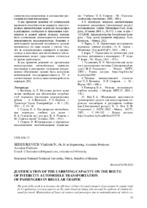Justification of the carrying capacity on the route of intercity automobile transportation of passengers in regular traffic
Bibliographic entry
Sedziukevich, V. N. Justification of the carrying capacity on the route of intercity automobile transportation of passengers in regular traffic / V. N. Sedziukevich // Транспорт и транспортные системы: конструирование, эксплуатация, технологии : сборник научных статей / Белорусский национальный технический университет ; редкол.: С. В. Харитончик (гл. ред.) [и др.]. – Минск : БНТУ, 2023. – Вып. 5. – С. 55-56.
Abstract
The goal of the work is to increase the efficiency of intercity road transport of passengers in regular traffic by optimizing carrying capacity on the route based on taking into account the patterns of random demand for travel. Minimization of losses of carriers and passengers due to underutilization of vehicle capacity and denial of travel to passengers at a probabilistic intensity of passenger traffic is proposed as an optimality criterion. The assumption has been put forward and confirmed that the intensity of passenger traffic can be described by a normal distribution law. Expressions are proposed for determining, depending on the accepted carrying capacity, the mathematical expectation of the daily number of passengers actually transported on the route and the mathematical expectation of the daily number of passengers who will be refused transportation on the route. Based on the work carried out, it was determined that at the optimal value of the carrying capacity reserve coefficient, which is the ratio of the values of the accepted carrying capacity to the average intensity of passenger traffic, during intercity road transport according to a predetermined schedule, the daily random demand for travel is almost completely satisfied. At the same time, the value of the carrying capacity safety factor is in the range of 1.07–1.28 by values of the coefficient of variation of passenger traffic intensity in the range of 0.15–0.25 and the length of the transportation route in the range of 50–300 km. It has been established that the optimal value of the carrying capacity safety factor increases with an increase in the coefficient of variation of passenger traffic intensity and a decrease in the travel distance of passengers. It was determined that the decision on the required carrying capacity on the route should be made taking into account periodic changes in the intensity of passenger traffic.

